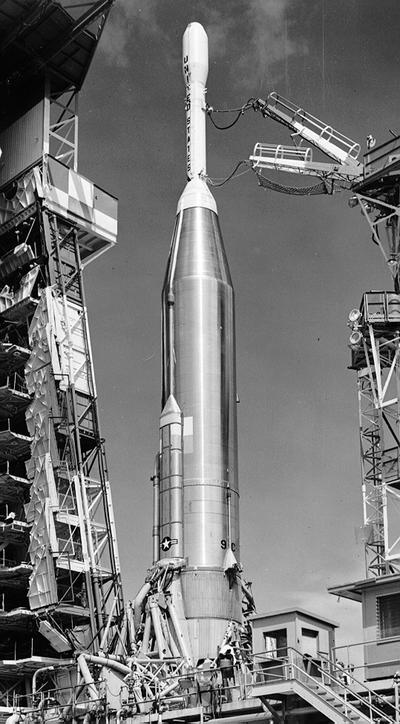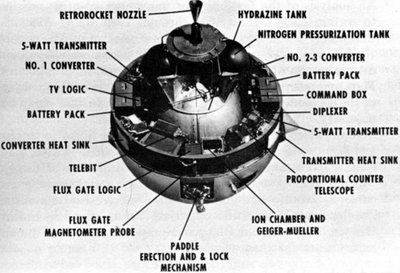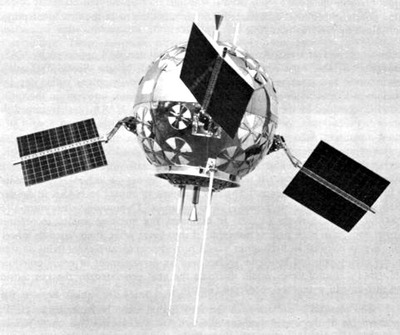The Pioneer lunar orbiters: a forgotten failureby Andrew J. LePage
|
| By the fall of 1959, the Able combination along with its cousin, the Vanguard upper stages, had an abysmal performance record. |
The Air Force’s first step beyond Earth orbit, called Project Able, was a series of attempts to place a small spacecraft into orbit around the Moon. These orbiters, along with a pair of small US Army-JPL lunar flyby probes, were part of the ARPA-sponsored Operation Mona, which was approved by President Dwight Eisenhower on March 27, 1958. Three launch attempts made by the Air Force between August and November of 1958, now called Pioneers 0, 1, and 2; all failed to reach the Moon. But even before these missions flew, the Air Force, in conjunction with the builders of their first lunar orbiters, STL (Space Technology Laboratory, a division of TRW), began to study follow-on missions not only to lunar orbit but also to Venus, given priority. Little was known about Earth’s near twin at this time and many believed Venus ranked with Mars as a likely abode for extraterrestrial life, making it a desirable target for exploration.
But these new missions would require a rocket larger than the Thor-Able used for the first unsuccessful Air Force lunar orbiter attempts. The Thor-Able was essentially a Thor IRBM topped with modified versions of the upper two stages of the Vanguard originally developed by the US Navy to launch America’s first satellites. Initially built for high-speed reentry tests of ICBM warheads, the Thor-Able was quickly adopted as a satellite launch vehicle and NASA eventually developed it into the famous Delta launch vehicle family. With more advanced upper stages still under development, a logical short-term solution to the problem of lofting the larger Air Force probes was to place the Able upper stages on a still larger rocket. In the end the Air Force selected their Atlas ICBM and the Atlas-Able was born.
The Atlas-Able
The first stage of the Atlas-Able consisted of a modified Convair-built Atlas D ICBM, which was over twice the size of the Thor. The Atlas program began in February of 1954 when it was recognized that an ICBM was a feasible weapon. The Atlas, which used kerosene and liquid oxygen as propellants, employed an innovative stage-and-a-half design where a pair of Rocketdyne XLR89 booster engines and their supporting structure were jettisoned after they were no longer needed during ascent. A XLR105 sustainer engine would then push the payload towards its target feeding off of the remaining propellants in the missile’s lightweight integral propellant tanks. The advantage of this arrangement was that all three engines, generating a total of 1.6 million newtons (360,000 pounds-force) of thrust, were ignited on the launch pad, thus avoiding the need for the then untried procedure of starting a large rocket engine in flight.
The Atlas A through C models were used for test flights starting in June of 1957, at first to validate then, later, refine the design of this large missile. A stripped-down version of the Atlas B was even launched into Earth orbit on December 18, 1958, carrying an experimental communication payload as part of ARPA’s Project Score. The Atlas D, eventually deployed operationally as an ICBM, was also designated for use as the booster for Air Force launch vehicles with upper stages like the Agena and the advanced, hydrogen-fueled Centaur. The Atlas D was also selected by NASA as the launch vehicle for the manned Mercury orbital missions. The first Atlas D test launch in April of 1959 failed, as did the next three attempts. The first Atlas D to meet it goals finally flew on July 28. After another successful flight from the Pacific Missile Range in California on September 9, the Atlas D was declared operational. But with only a 61% success record by November 1959, the Atlas D was not yet very reliable.
| Despite the budget problems and tight schedule, the new STL-built lunar orbiters were the most advanced American spacecraft to date. |
The upper stages of the Atlas-Able were nearly identical to those used in the Thor-Able. The second stage was 84 centimeters (33 inches) in diameter and about 6.7 meters (22 feet) long, 0.65 meters (2.1 feet) longer than the version flown on the Thor-Able. The other major difference in the second stage was the substitution of the lighter Aerojet AJ10-101 engine for the AJ10-42 used in the Thor-Able. The AJ10-101 used a highly toxic combination of UDMH (Unsymmetrical DiMethyl Hydrazine) and IRFNA (Inhibited Red Fuming Nitric Acid) to generate 34,000 newtons (7,700 pounds-force) of thrust. The X-248 solid rocket motor built by the Allegheny Ballistic Laboratory topped off the stack, as it did on the Thor-Able and later versions of the Vanguard. It generated about 14,000 newtons (3,100 pounds-force) of thrust for 40 seconds. At launch, the Atlas-Able stood about 30 meters (98 feet) tall and weighed in at about 120 metric tons (265,000 pounds).
By the fall of 1959, the Able combination along with its cousin, the Vanguard upper stages, had an abysmal performance record. In total, Able and its relatives had flown successfully only six times out of their first sixteen opportunities. Combined with the less than stellar success record of the Atlas at that time, things were bound to go wrong with the Atlas-Able.
 The first Atlas-Able as it appeared after assembly on Pad 12 at the Atlantic Missile Range. The Atlas 9C first stage exploded during a static test firing on September 24, 1959. (credit: USAF) |
A change of plans
Once NASA started operations in October of 1958, virtually all purely scientific space programs run by the military were transferred to the new civilian space agency. This included not only the remaining flights originally part of ARPA’s Operation Mona, but also the follow-on probes the Air Force was planning. In November of 1958 NASA essentially adopted the existing Air Force plans as part of their nascent Pioneer program and started work to launch a pair of probes to Venus during the June 1959 launch window. After this a lunar orbiter mission was planned. But these plans changed during the spring of 1959. After the successful launch of the Soviet Luna 1 in January 1959 and the failure of not only the first three Air Force lunar orbiters but the first Army-JPL probe, Pioneer 3, the near-term goals of the Pioneer program were redirected.
The new plan called for a series of spin-stabilized probes built by STL to be launched with each mission building on the experience of the earlier ones. The first was the “Able-3” mission. Designated as S-2 by NASA, this satellite scheduled to be launched into an elongated 12-hour Earth orbit in August of 1959 using the Thor-Able. It would test the basic spacecraft design and instruments. The next planned mission was the “Able 4 Atlas” mission, whose payload was designated as P-1 by NASA. The goal of this mission was to launch a probe into lunar orbit in September of 1959 using the new Atlas-Able. In November, “Able 4 Thor”, designated P-2 by NASA, would be launched on a deep space mission towards the orbit of Venus using a Thor-Able.
Ideally NASA officials would have wanted more time and resources to improve the reliability of the Atlas-Able by replacing the Able stages with enhanced versions from their Thor-Delta program. But budget limitations brought on by the spiraling costs of other NASA programs and the fear of what the next Soviet space spectacular would bring did not allow it.
Despite the budget problems and tight schedule, the new STL-built lunar orbiters were the most advanced American spacecraft to date. The probe was a spin stabilized, aluminum alloy sphere one meter (39 inches) in diameter with a planned mass of 165 kilograms (364 pounds). With no active attitude control system, the spinning probe essentially maintained the same orientation it had after launch for its entire mission. Attached to the exterior were four paddles 60 centimeters (24 inches) square covered with 2,200 solar cells that would be deployed after launch. With no batteries, the lunar orbiter would rely solely on these paddles for power.
At each end of the probe was a small monopropellant rocket engine generating 90 newtons (20 pounds-force) of thrust. Either could be used in bursts of up to four seconds for course corrections during the 2.6-day flight to the Moon while the forward-facing engine would provide a velocity change of 1,070 meters per second (3,500 feet per second) to place the probe into lunar orbit. For the first mission, a 5,060 by 5,420 kilometer (3,140 by 3,370 mile) orbit inclined 42 degrees to the lunar equator with a period of 12 hours was planned. The 63 kilograms (138 pounds) of hydrazine propellant for these engines was kept in a pressurized 66-centimeter (26-inch) diameter sphere inside the probe. The hydrazine would spontaneously decompose inside the throat of the engines after it had passed over a bed of an aluminum oxide catalyst.
Thermal control was provided by 50 four-blade blue and white butterfly fans controlled by bimetallic coils. As they heated and expanded, the butterfly fans would open, exposing more white and less blue to reflect heat. When cooled, the butterfly fans would close, exposing more blue to allow more heat to be absorbed. This complex thermal control system was required due to the amount of instrumentation carried and the more demanding thermal environment this mission would encounter compared to earlier spacecraft.
Each probe carried a variety of instruments to measure the magnetic and radiation environment around the Moon. In addition, a simple scanning imager was carried to return the first images of the unseen lunar far side. Similar to models carried by the earlier USAF lunar orbiters, it would rely on a combination of the orbiter’s spin and forward motion to build up a crude 128 by 128-pixel image of the scene below. All of these instruments were tested by S-2 which was renamed Explorer 6 when it was launched on the first fully successful flight of the Thor-Able on August 7, 1959.
 A view of the interior of the Pioneer lunar orbiter. (credit: NASA) |
The missions
The biggest obstacle for the new Pioneer Moon program was the availability of Atlas D missiles. The manufacturer’s assembly lines simply could not keep up with the demand for the missile. While still important to national prestige, NASA’s new Moon probes had lower priority than defense programs and Project Mercury. In order to get their first new Pioneer launched on the scheduled date of October 3, 1959, officials decided to substitute a surplus Atlas C as the booster—the only C-model to be used in a space shot. The Atlas C, which had been deployed as an ICBM in limited numbers, was used for flight testing and the training of missile crews. But the program suffered its first setback during a 24-second static test firing of Atlas 9C on Pad 12 at the Atlantic Missile Range (AMR) in Florida on September 24, 1959. Although the firing itself was successful, a propellant line ruptured as the Atlas’ engines shut down resulting in an explosion that destroyed the rocket and launch pad. Fortunately the payload was not attached.
| In the end, seven out of eight of America’s first probes to the Moon launched between August 1958 and the end of 1960 were failures. |
For the next attempt, NASA diverted an Atlas D from its Mercury program. Atlas 20D was originally the backup launch vehicle for Mercury’s Big Joe unmanned test flight and was no longer needed. On November 26, 1959, Atlas-Able with the 169-kilogram (373-pound) Pioneer P-3 lifted off from Pad 14 at 2:26 am EST. All was going well until about 45 seconds into the flight when the bulbous fiberglass payload shroud ripped away under the aerodynamic loads, destroying the third stage and probe in the process. The problem was found to be excess pressure building up inside the shroud during ascent. This was corrected by drilling some tiny bleed holes into the shroud to help the pressure equalize.
In April of 1960 NASA authorized the building of a new pair of 176-kilogram (387-pound) “Able-5” probes designated P-30 and P-31. Similar to the earlier P-3, these probes included a number of minor design refinements and replaced the camera with additional instruments to characterize the radiation environment near the Moon. Since the Soviet Luna 3 had already photographed the far side of the Moon in October 1959, the comparatively primitive camera carried by Pioneer was now considered redundant. The new probes would be placed into a 2,300 by 4,000 kilometer (1,400 by 2,500 mile) orbit around the Moon. A shortage of Atlas D missiles, a lack of funding, and scheduling conflicts with other programs for the only two available Atlas launch pads forced NASA to delay the next Pioneer lunar orbiter launch. In the mean time, NASA’s P-2 deep space probe, rechristened Pioneer 5, was launched on March 11, 1960, using a Thor-Able. Despite months of delays, Pioneer 5 would prove to be the most successful of the original STL-built Pioneer spacecraft.
After a months-long wait for an Atlas booster and an available launch pad, the Atlas-Able carrying Pioneer P-30 lifted off from a rebuilt Pad 12 at 11:13 am EST on September 26, 1960. While the Atlas 80D booster operated as intended, the oxidizer system in the second stage’s engine malfunctioned, resulting in the engine developing only 70% thrust. A further malfunction caused the ascending rocket to start tumbling. The third stage fired upon command from the ground and the probe successfully fired its hydrazine engine to separate from the spent rocket motor. But without attaining the proper velocity and far off course, the payload was destroyed upon reentry 17 minutes after launch.
The last Pioneer lunar orbiter, P-31, was launched from Pad 12 at 3:40 am on December 15, 1960. Like too many Atlas flights at that time, the Atlas 91D booster exploded at an altitude of 12,000 meters (40,000 feet) after only 68 seconds of powered flight. A subsequent investigation cleared the Atlas D and showed that the second stage had ignited prematurely, resulting in the destruction of the ascending rocket. With this last failure, NASA had nothing to show after an expenditure of $40 million (about $300 million in today’s dollars). Given the poor performance of the Atlas-Able and the fact that lunar missions with newer designs were already being developed, the Pioneer lunar orbiter program was cancelled.
In the end, seven out of eight of America’s first probes to the Moon launched between August 1958 and the end of 1960 were failures. Only the diminutive 6.1 kilogram (13.4 pound) Army-JPL Pioneer 4 launched on March 3, 1959, by a team led by famed German rocket engineer Wernher von Braun managed to escape the Earth and make it anywhere near the Moon. During this same time, the Soviet Union managed three spectacularly successful missions that were the first to fly by the Moon (Luna 1), the first to impact the Moon (Luna 2), and the first to photograph the unseen far side (Luna 3). Although the Soviet Union also suffered a half-dozen failures during this period, they were kept secret, unlike America’s very public failures. Today’s lunar missions owe much to the lessons learned from successes and failures of these early Soviet and American missions.
Bibliography
P.F. Glaser and E.R. Spangler, “The Able-5 Lunar Satellite”, STL, 1960
Robert Reeves, The Super Power Space Race, Plenum, 1994
Keith J. Scala, “Atlas-Able: A Forgotten Failure”, Quest, Vol. 4, No. 1, pp. 36-37, Spring 1995
Chuck Walker with Joel Powell, Atlas - The Ultimate Weapon, Apogee Books, 2005
“A Development Plan for Two Interplanetary Probes (Able 4)”, STL, 14 January 1959
“Development Plan for Able 3-4 (Earth Satellite, Lunar Satellite, Deep Space Probe)”, STL, 1 June 1959
“Pioneer P-3”, NSSDC Master Catalog, Last accessed on December 6, 2010
